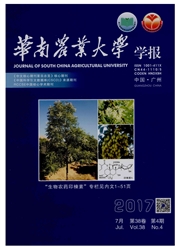

 中文摘要:
中文摘要:
【目的】对黏细菌GIM1.813的菌株背景进行了解,为后期抗耐甲氧西林金黄色葡萄球菌(MRSA)活性物质的分离、鉴定奠定基础。【方法】通过菌落形态观察、扫描电镜、生理生化特征以及16S rRNA基因序列同源性分析,鉴定并归类细菌。同时,比较分析7种发酵培养基对GIM1.813产生活性物质的影响,并运用正交法对选出的培养基和发酵培养条件进行优化。【结果】GIM1.813的最适p H和最适温度分别为7.0和30.0℃,能耐受10 g·L^-1的Na Cl。文中还提供了该菌株的生理生化、基因组DNA G+C含量和醌型数据。GIM1.813在7种发酵培养基中均生长良好,在IVY/2培养基中产生的代谢产物抑菌活性最高。正交法优化后,GIM1.813的发酵液抗MRSA活性提高了49.12%,且发酵过程中菌株生长情况改善。【结论】经鉴定,菌株GIM1.813为弱小珊瑚球菌Corallococcus exiguous。通过发酵优化,菌株GIM1.813分泌抗MRSA活性物质的能力显著提高,同时发现Mg^2+以及淀粉能显著影响珊瑚球菌产天然产物的能力。
 英文摘要:
英文摘要:
[ Objective ] In this report, strain GIM1.813 was investigated, prepared for future isolation and identification of anti-methieillin-resistant Staphylococcus aureus (MRSA) bioactive products. [ Method ] According to colonial morphology, scanning electron microscopy, physiological and biochemical charac- teristics, and phylogenetic analysis based on 16S rRNA genes, GIM1. 813 was identified and classified. The effects of seven mediums on the active compounds producted by strain GIM1. 813 were compared. The chosen medium and fermentation conditions were optimized by orthogonal experiments. [ Result ] The optimal pH and temperature for strain GIM1. 813 were 7.0 and 30. 0 ℃, respectively, and the strain could tolerate up to 10 g ·L^-1NaCl. The data of physical-chemical characteristics, chromosomal DNA G + C eoncents and quinines of this strain were also presented. Strain GIM1. 813 grew well in all seven tested mediums, while it produced metabolites with the maximum antibacterial activity in IVY/2 medium. After fermentation optimization, the anti-MRSA activity of fermentation broth increased by 49.12% and the strain GIM1. 813 grew better. [ Conclusion] Strain GIM1. 813 was classified as Corallococcus exigu- ous. Its ability of producing anti-MRSA bioactive components was improved significantly by fermentation optimization. Meanwhile, Mg^2+ and starch were found to significantly improve the ability of myxobacteria to produce bioactive components.
 同期刊论文项目
同期刊论文项目
 同项目期刊论文
同项目期刊论文
 期刊信息
期刊信息
